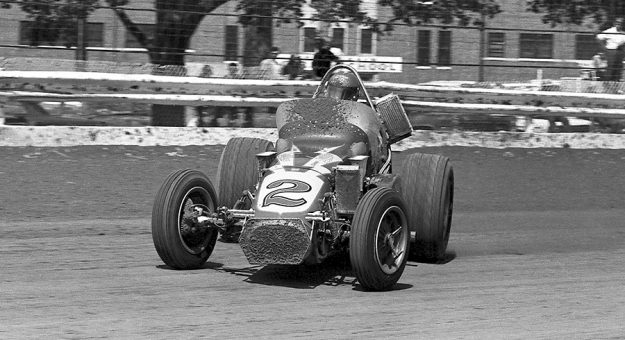INDIANAPOLIS — He didn’t have A.J. Foyt’s thunder, Mario Andretti’s worldly grace, Johnny Rutherford’s charm, Gordon Johncock’s outsized tenacity or his own brother Bobby’s outrageous gift for gab.
Lacking those tools, Al Unser made do with what he had. He punched in, put on his uniform and got to work.
He might have been the best blue-collar racer this country ever produced. His job was winning and few did it as well. Four times, Unser topped the Indianapolis 500. Three times — twice with USAC, once with CART — he was the Indy car champion.
In 1978, saddled with a Lola he disliked, he did what laborers do: He kept his mouth shut and his head down. By that autumn, he was the only man ever to sweep USAC’s Triple Crown, the 500-milers at Indianapolis, Pocono Raceway and Ontario Motor Speedway.
When Unser died in early December, the news was jarring. In hindsight, it shouldn’t have been. Big Al was 82 and he’d been through a long fight with cancer.
But he lived like he raced, keeping below the radar until it was time to write another headline, so his final headline was a heartbreaker.
To a racing public — and, yes, a racing media — too often drawn to the shiny and the superficial, it was easy to overlook Al Unser. He never made a scene and his default style in interviews was to get to the point without giving away too much.
If Foyt was feeling talkative, his response to a question about that weekend’s Indy car race might include flashbacks to glorious old sprint car scenes from Ascot Park or Williams Grove.
Likewise, if you asked Bobby Unser about the weather, he might also tell you about the time a broken rear-end gear cost him certain victory in the Turkey Night Grand Prix for USAC midgets.
Big Al’s way was different. In the winner’s interview at Indianapolis in 1978, someone asked him about the race’s safe, clean start. “I think everybody has finally decided,” he replied, “that you’re not going to win the race on the first lap.”
Another reporter wondered how that Indy victory compared with those in 1970 and ’71. The memorable part of Unser’s brief answer was, “It’s the one I got up for this morning.”
As a result, he wasn’t the easiest driver to get to know, whether you were watching from the press box or through a TV screen. But the right folks in pit areas from Langhorne to Los Angeles knew that come race day, Al Unser would tighten his belts and give it his all.
Look at the team owners who recruited him. He drove Indy cars for Foyt, John Mecom Jr., Bill Ansted and Shirley Murphy, Al Retzloff, Bobby Hillin, John Menard, Kenny Bernstein, and the four bosses with whom he conquered Indianapolis: Vel Miletich, Parnelli Jones, Jim Hall and Roger Penske.
When he felt like road racing, Unser ran sports cars for Frank Arciero, Lee Dykstra, Preston Henn, Al Holbert and Jochen Dauer; made a few Can-Am starts for Paul Newman; attacked Formula 5000 with Miletich; and went big in his only two Trans-Am starts, one each for Smokey Yunick and Bud Moore.
And he had no trouble finding stock car rides. At the apogee of USAC’s stock car class, Big Al had a happy seven-year stint with Rudy Hoerr. Although he seldom ventured into NASCAR, car owners such as Cotton Owens and Buddy Baker were glad to accommodate Unser when he did.
Name another mercenary driver with a comparable list of employers.
Indy car racing was Al’s steady gig, but he was a threat wherever he went moonlighting. The Rolex 24 At Daytona? Unser won it in 1985, sharing a Porsche with Foyt, Bob Wollek and Thierry Boutsen. The Hoosier Hundred on the dirt mile at the Indiana State Fairgrounds? He won that won four times in a row.
The International Race of Champions? Al was the 1978 champion. Pikes Peak? How dare you question an Unser’s hill-climb cred? Al won it in ’64.
In his one and only Daytona 500, the 1968 edition, he finished a lead-lap fourth. The only men ahead of him were winner Cale Yarborough, LeeRoy Yarbrough and Bobby Allison. Fifth through eighth, each at least one lap down, were David Pearson, Paul Goldsmith, Darel Dieringer and Richard Petty.
Pull on the helmet, and go to work.
Parnelli Jones, who co-owned the cars Unser drove to victory at Indianapolis in 1970 and ’71, and whose fabled “Super Team” later paired Big Al with Mario Andretti, marveled at how Unser could baby his equipment and still win races.
“When Mario climbed out of his car after a race, every piece of it was used up,” said Jones. “And I’m not knocking Mario; I’d been the same way. But you could look at Al’s car after he’d just won the Indy 500 and the damn thing would be fresh enough to run the whole race over again.”
I mentioned that to Big Al one day. He paused a moment, as if thinking of all those checkered flags and all those cars.
Finally, he said, “I just drove ’em the way I thought would win the race.”
Exactly as he’d been hired to do.
